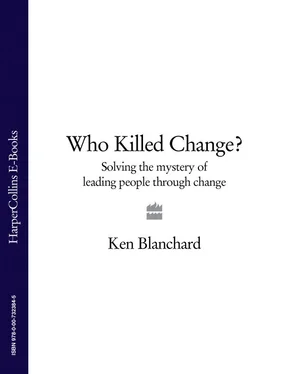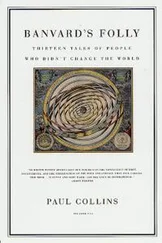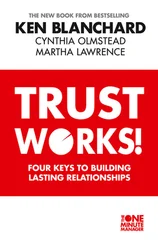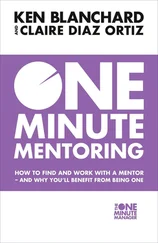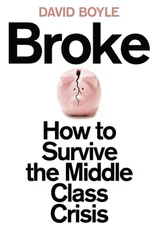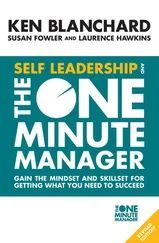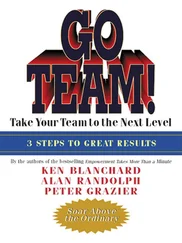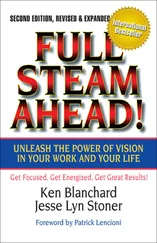KEN BLANCHARD
bestselling author of The One Minute Manager
who killed change?
solving the
mystery of leading people
through change
with JOHN BRITT PAT ZIGARMI JUDD HOEKSTRA

In loving memory of
Alice Britt Caldwell
1943-2007
and
Gerald A. Embry
1941-2008
Chapter 1 - Scene of the Crime
Chapter 2 - Suspect #1: Culture
Chapter 3 - Suspect #2: Commitment
Chapter 4 - Reflections on Culture and Commitment
Chapter 5 - Suspect #3: Sponsorship
Chapter 6 - Suspect #4: Change Leadership Team
Chapter 7 - Suspect #5: Communication
Chapter 8 - Reflections on Sponsorship, Change Leadership Team and Communication
Chapter 9 - Suspect #6: Urgency
Chapter 10 - Suspect #7: Vision
Chapter 11 - Reflections on Urgency and Vision
Chapter 12 - Suspect #8: Plan
Chapter 13 - Suspect #9: Budget
Chapter 14 - A Vision of Death
Chapter 15 - Suspect #10: Trainer
Chapter 16 - Suspect #11: Incentive
Chapter 17 - Reflections on Plan, Budget, Trainer and Incentive
Chapter 18 - Suspect #12: Performance Management
Chapter 19 - Suspect #13: Accountability
Chapter 20 - Super Cops and Stakeholders
Chapter 21 - The Autopsy Report
Chapter 22 - Murderer Announced: Invitation Only
Chapter 23 - Change Lives!
Chapter 24 - Helping Change Thrive in Your Organization
Resources
About the Authors
Also by Ken Blanchard
Copyright
About the Publisher
AGENT Mike McNally’s dark sedan skidded up to the front door of the ACME organization under a stormy night sky. The single blue light rotating on the hood contrasted eerily with the distant flashes of lightning. McNally got out of his car, brushed the ashes from his overcoat and took a last drag on his cheap cigar.
This was his third homicide case this month, all with the same last name—Change. In fact, the investigation of Change fatalities had become his life’s work. A clear pattern to the deaths had emerged over the years. Change would be introduced to an organization with varying degrees of reception. From all appearances Change would begin to integrate into the organization and then, without warning, Change would be found dead, quite often with no apparent injury. The evidence was always scant and a sole perpetrator had never been identified.
This time McNally was determined to catch the killer. He extinguished his cigar, took his notebook from his pocket and slowly walked toward the door.
McNally slipped under the yellow Do Not Cross police tape and walked into the conference room. The room buzzed with activity. A photographer was taking pictures of the deceased from different angles, and people in groups of two and three were giving their opinions on what had happened. At the far end of the room, Change’s body was slumped over the conference table. Just out of reach of his right hand was an overturned glass. The table was still wet from the spill.
A man unknown to McNally came up to him and handed him a folded note. “The medical examiner asked me to give this to you,” he said.
McNally unfolded the note and read:
probably a homicide
poisoning is the most likely cause of death
death was most likely between 7 and 9 a.m. today
more after the autopsy
McNally cleared the room, closed the door and began his investigation of the crime scene. When he emerged an hour later, a woman was waiting for him outside the door.
“My name is Anna,” she said. “I’ll be your assistant. I’ve been told to take care of whatever you need.”
McNally knew who the primary suspects were. He had done this many times before. The usual suspects were always the same. He opened his notebook and looked at the list he’d prepared:
1 Culture—defines the predominant attitudes, beliefs and behavior patterns that characterize the organization
2 Commitment—builds a person’s motivation and confidence to engage in the new behaviors required by the Change
3 Sponsorship—a senior leader who has the formal authority to deploy resources (e.g., time, money and people) toward the initiation, implementation and sustainability of the Change; ultimately responsible for the success of the Change
4 Change Leadership Team—actively leads the Change into the organization by speaking with one voice and resolving the concerns of those being asked to change
5 Communication—creates opportunities for dialogue with change leaders and those being asked to change
6 Urgency—explains why the Change is needed and how quickly people must change the way they work
7 Vision—paints a clear and compelling picture of the future after Change has been integrated successfully
8 Plan—clarifies the priority of the Change relative to other initiatives and responsibilities; works with those being asked to change to develop a detailed and realistic implementation plan, then to define and build the infrastructure needed to support the Change
9 Budget—analyzes proposed Changes from a financial perspective to determine how best to allocate limited resources and ensure a healthy return on investment (ROI)
10 Trainer—provides learning experiences to ensure those being asked to change have the skills needed to follow through with the Change and succeed in the future organization
11 Incentive—recognizes and/or rewards people to reinforce desired behaviors and results that enable Change
12 Performance Management—sets goals and expectations regarding behaviors and results that enable Change, tracks progress toward the goals and expectations, provides feedback and training and formally documents actual results versus desired results
13 Accountability—follows through with people to ensure their behaviors and results are in line with agreed upon goals and expectations and that leaders are walking the talk, and institutes consequences when behaviors or results are inconsistent with those that enable Change
McNally tore the sheet of paper from his notebook and handed it to Anna. “I need to interview these people as soon as possible,” he said. “I’m thinking thirty to forty-five minutes per person. Can you arrange that?”
“I’ll get right on it,” she said.
“Also, it would be great if you could get me a copy of the org chart, so I can see who works for whom,” McNally added.
The assistant had anticipated this request. She handed McNally a copy of the organizational chart. Then she was gone.
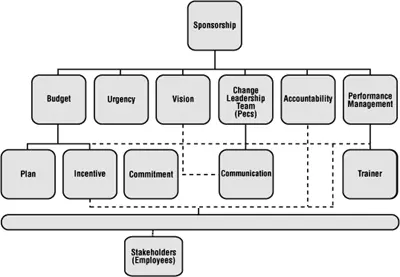
Конец ознакомительного фрагмента.
Текст предоставлен ООО «ЛитРес».
Прочитайте эту книгу целиком, купив полную легальную версию на ЛитРес.
Безопасно оплатить книгу можно банковской картой Visa, MasterCard, Maestro, со счета мобильного телефона, с платежного терминала, в салоне МТС или Связной, через PayPal, WebMoney, Яндекс.Деньги, QIWI Кошелек, бонусными картами или другим удобным Вам способом.
